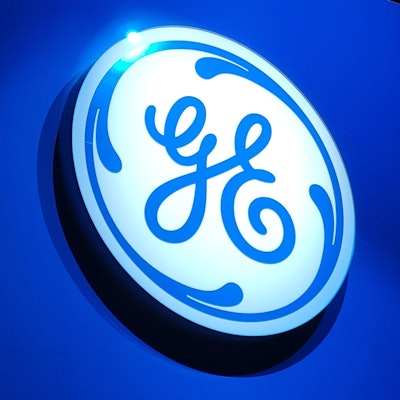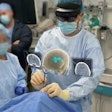
With GE HealthCare set to emerge as its own standalone company early next year, executives highlighted the firm's strategy for precision healthcare during Investor Day presentations on December 8 in New York City.
In his opening talk, Peter Arduini, president and CEO of GE HealthCare, emphasized the breadth of GE's portfolio for facilitating precision healthcare. When the spinoff from GE is complete, GE HealthCare will have four focused segments: Imaging (CT, MRI, molecular imaging, x-ray, women's imaging, and image-guided therapy), Ultrasound, Patient Care Solutions (patient monitoring systems, etc.), and Pharmaceutical Diagnostics (contrast media and radiopharmaceuticals).
"We're the only company out there that has these devices, has these agents, and also has the digital depth," Arduini said.
Digital platforms -- such as software-connected tools and artificial intelligence (AI)-integrated products -- also currently generate approximately $1 billion in sales across all GE HealthCare's business segments, according to Arduini.
"That's a fast-growing area for us and an area that we're focused on amping up for a lot of reasons; one is direction and the other is what it could do for our overall margin," he said.
The four segments are also supported by a large service organization that can also provide multivendor service capabilities, Arduini said.
Precision healthcare requires: "smart" devices, a focus on disease states, and a digital platform, he said.
"You need to have all three," he said.
GE HealthCare will begin trading on the Nasdaq on January 4 under the symbol "GEHC."
Growth, investment
As an independent company, GE HealthCare expects it will deliver mid-to-single digit organic revenue growth over the midterm, with high-teens to 20% adjusted earnings before interest and taxes (EBIT) margin.
Arduini noted that GE HealthCare is focusing its research and development (R&D) spending in five areas:
- Premium CT/photon-counting CT technology
- Cardio/3D image-guided therapies
- Handheld ultrasound
- Oncology molecular imaging/theranostics
- MR platforming
- AI and GE's Edison platform
"Today there really isn't a product coming out that's not enabled with some form of artificial intelligence," Arduini said.
The four business segments will have their own priorities in terms of focusing more on revenue growth or profitability. In the Imaging segment, GE HealthCare will be focusing on margin, emphasizing higher-margin new product introductions, platforming initiatives, and digital/artificial intelligence technology to drive growth, he said.
Revenue is the priority, however, for the Ultrasound segment. To accomplish this goal, GE HealthCare plans to utilize new product introductions to drive innovation and seek to expand into adjacent market sectors. It also plans to broaden the digital ecosystem, according to the vendor.
The company is also prioritizing revenue growth in the Pharmaceutical Diagnostics segment. The focus here is on expanding capacity, optimizing pricing, and developing new products, Arduini said.
Imaging segment
In imaging, GE HealthCare hopes to take advantage of market trends, including the increasing penetration of imaging technologies in diagnosis, the growth in broad-based population screening programs, and the expanding indications for technology/artificial intelligence in high-end diagnostic exams, according to Jan Makela, Imaging CEO. In addition, new therapeutic procedures require precision imaging guidance, he said.
As of the third quarter of 2022, GE HealthCare's Imaging unit – the largest in the company – had produced $7.3 billion in revenue, up from $7 billion for the same timeframe in 2021. Although EBIT margin dipped, however, from 13.2% to 10.7% GE HealthCare has set a medium-term goal to achieve a high-teens EBIT margin.
Growth will be sparked by broadening its portfolio across care pathways, delivering its service capabilities, expansion of its digital/AI capabilities with GE HealthCare's Edison platform, and a focus on execution, according to the vendor.
Ultrasound
Meanwhile, GE HealthCare's Ultrasound segment seeks to benefit from its diagnostic capabilities and large installed base, according to Roland Rott, Ultrasound CEO. It also seeks to accelerate industry expansion and adoption of ultrasound in therapy guidance, screening, and point-of-care applications, he said.
AI offers much potential for increasing productivity in potential, sharply decreasing scan times, according to Rott. Automation and AI will also open up new markets, he said.
The ultrasound segment generated $2.5 billion in revenues through the third quarter, up from $2.3 billion for the first nine months of 2021. Segment margin has dipped slightly, however, from 26.7% to 25.3%.
The plan in ultrasound is to grow its leadership position via innovation and commercial "intensity," Rott said. The unit also wants to expand into attractive adjacent markets and broaden its digital capabilities and ecosystems in ultrasound.
"We couldn't be more excited about the potential ultrasound has both as a business as well as modality in healthcare," he said.
Pharmaceutical Diagnostics
The Pharmaceuticals Diagnostics segment's product portfolio includes contrast media for x-ray/CT, MR, and ultrasound exams, as well as radiotracers for SPECT and PET imaging.
The Pharmaceuticals Diagnostics segment produced $1.5 billion in revenues through the third quarter of 2022, flat compared with the $1.5 billion reported in the first nine months of 2021. The unit has third-quarter segment EBIT margin so far of 27.7%, down from 36.5% a year ago.
In iodinated contrast applications, GE HealthCare plans to invest in expanding manufacturing capacity and implementing pricing initiatives, as well as improving efficiency and reducing waste, said Kevin O'Neill, Pharmaceutical Diagnostics CEO.
Responding to the shortage of iodinated CT contrast media that occurred earlier this year and to meet expected growth in demand, GE HealthCare has worked to expand its manufacturing capacity. These initiatives included adding a new manufacturing line at its contrast media production facility in Cork, Ireland, as well as plans to invest $80 million to increase manufacturing capacity by 30% at its Active Pharmaceutical Ingredients site in Lindesnes, Norway.
"We see growth in iodinated contrast media doubling over the next 10 years," O'Neill said. "We're the industry leader today, and it's absolutely critical that as a leader we ensure security and supply for our customers."
Furthermore, the company inked a supply deal with Chile-based mining firm SQM to increase supply of iodine raw material.
In MRI, GE HealthCare plans to launch branded generic agents and develop nongadolinium alternative MRI agents. And in ultrasound contrast media, GE HealthCare wants to expand sales of Optison and Sonazoid.
In molecular imaging, GE HealthCare seeks to build on its position in neurology while building out its oncology platform and expanding in cardiology. Theranostics also creates a growth opportunity, according to O'Neill.



















